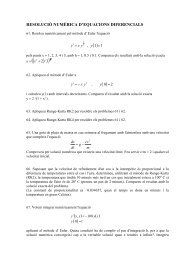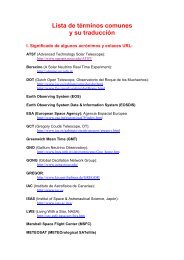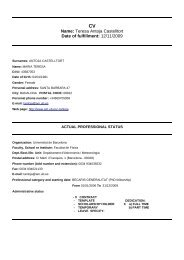Universitat de - Departament d'Astronomia i Meteorologia ...
Universitat de - Departament d'Astronomia i Meteorologia ...
Universitat de - Departament d'Astronomia i Meteorologia ...
You also want an ePaper? Increase the reach of your titles
YUMPU automatically turns print PDFs into web optimized ePapers that Google loves.
2.8. A proposed scenario to explain the multiwavelength behavior 83<br />
We can use the values quoted above, together with v = 0.2c and an energy of<br />
E0 = 5 × 10 −4 erg for the electrons injected at the base of the jet, to solve for z0 in<br />
this quadratic equation. The obtained results are 0.35, 0.85 and 1.30 AU for ɛ = 1,<br />
1/2 and 1/3, respectively. The synchrotron term can be shown to be negligible a<br />
posteriori and has not been consi<strong>de</strong>red here.<br />
Hereafter, we will proceed taking into account only the adiabatic expansion term,<br />
because it is dominant compared to the IC one, and rewrite Eq. 2.8 as:<br />
dE<br />
dt<br />
−2ɛ<br />
3<br />
vE<br />
z<br />
. (2.11)<br />
This can be easily integrated to give E E0(z/z0) −2ɛ/3 . As the energy <strong>de</strong>cays, the<br />
synchrotron emission of relativistic electrons will shift towards lower frequencies. In<br />
particular, the synchrotron frequency expected at a distance z is given by:<br />
νc = 6.27 × 10 18 BE 2 6.27 × 10 18 B0E 2 0 (z/z0) −7ɛ/3 . (2.12)<br />
The electrons still producing 6 cm (νc = 5 × 10 9 Hz) synchrotron emission at about<br />
z = 1000 AU (the size of the MERLIN jets) are probably those originally injected<br />
with energies of E0 5 × 10 −4 erg. Then, the magnetic field B0 at the base of the<br />
jet can be roughly estimated as:<br />
B0 8.0 × 10 −10 E −2<br />
0<br />
z<br />
z0<br />
7ɛ/3<br />
. (2.13)<br />
This provi<strong>de</strong>s values of 3.6 × 10 5 , 12 and 0.6 G for ɛ = 1, 1/2 and 1/3, respectively.<br />
If magnetic flux is conserved, the corresponding field at the end of the MERLIN<br />
jet would be B1000 AU = 128, 0.4 and 0.06 G. For comparison, the only in<strong>de</strong>pen<strong>de</strong>nt<br />
estimates of the magnetic field in the LS 5039 jets come from simple equipartition<br />
arguments. The results are merely indicative of the average magnetic field in the<br />
solid angle of the sky covered by the jets. Using the total flux <strong>de</strong>nsity and size of the<br />
MERLIN jets given in Table 2.3 we <strong>de</strong>rive a field value of > 8×10 −3 G, although this<br />
is only a lower limit because the jet width is unresolved. The VLBA image presented<br />
in Sect. 2.4.4, allowed us to estimate an approximate magnetic field of ∼ 0.2 G for<br />
radio jets reaching up to a few mas. It is clear that a field of such intensity is more<br />
consistent with the ɛ < 1 results than with the too high magnetic fields implied<br />
by a simple conical jet (ɛ = 1). Therefore, a slowly expanding jet, and hence well<br />
collimated, is favored to power the LS 5039 radio emission up to ∼ 1000 AU by<br />
the electrons that previously contributed to the γ-ray emission, without in situ<br />
acceleration being required. This is also in agreement with our upper limit of ≤ 6 ◦<br />
for the jet half opening angle <strong>de</strong>rived from the EVN map.






